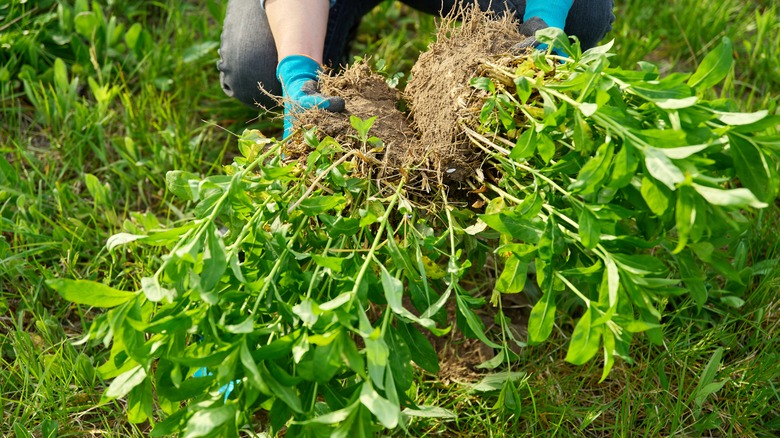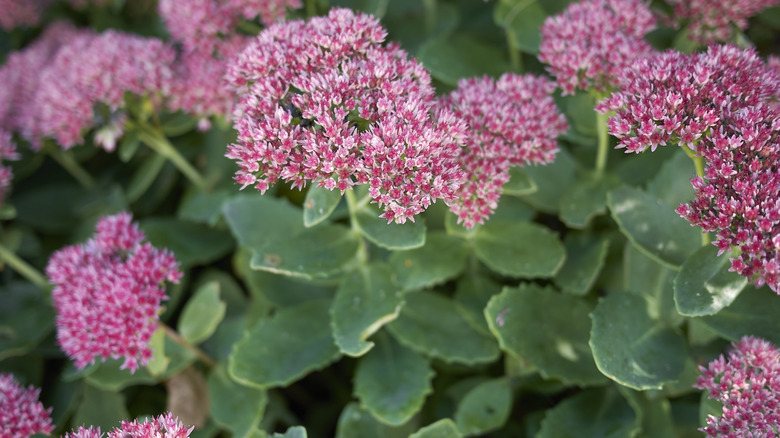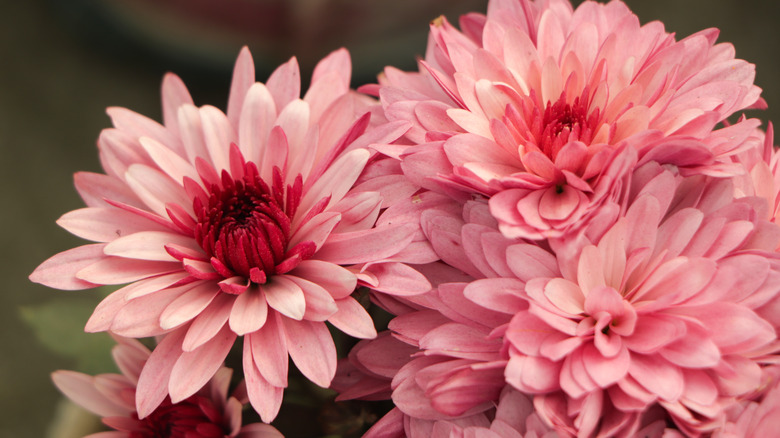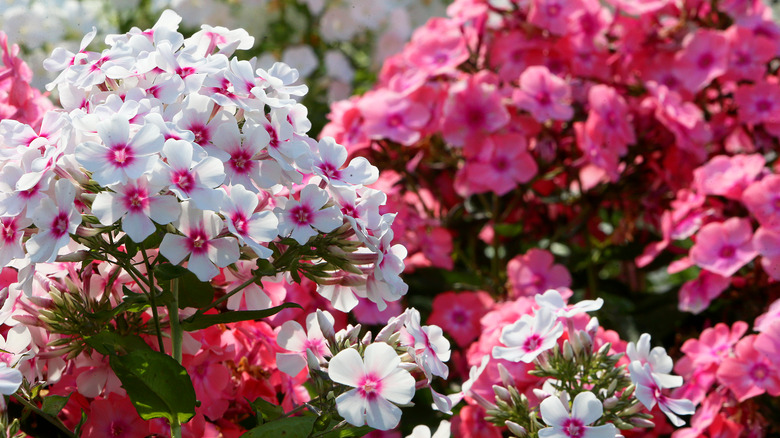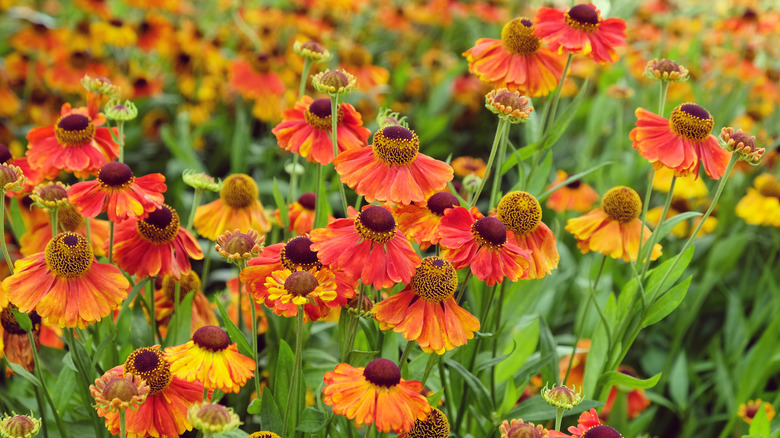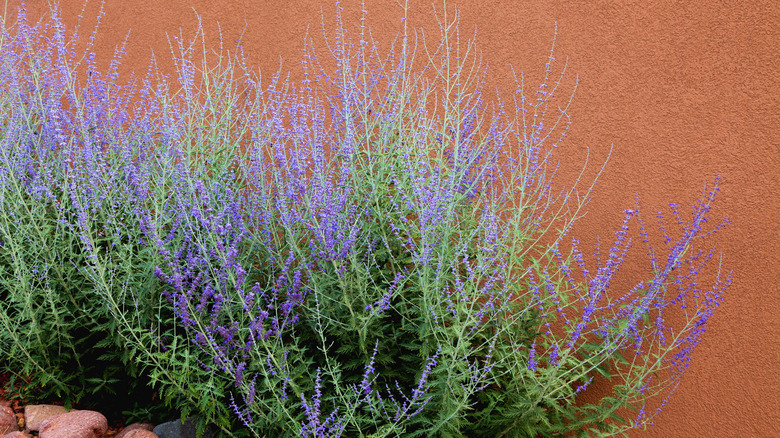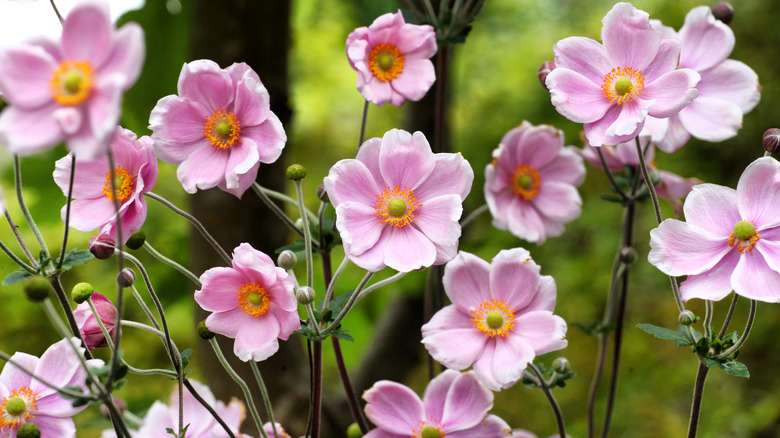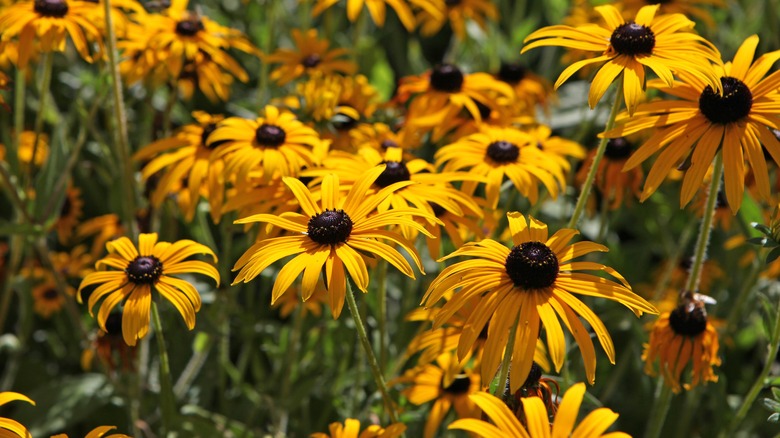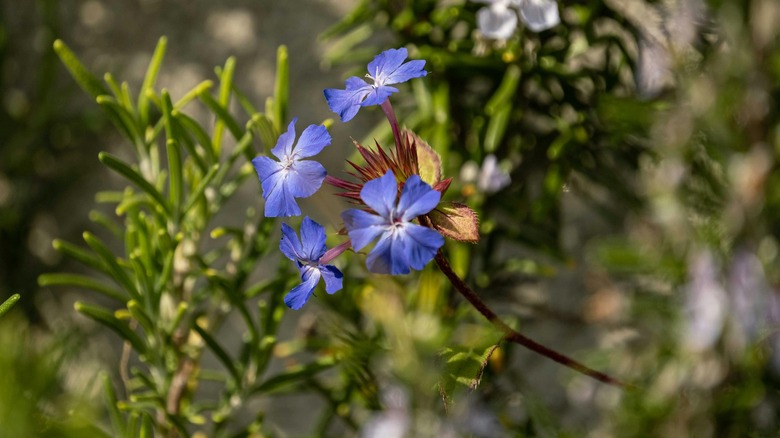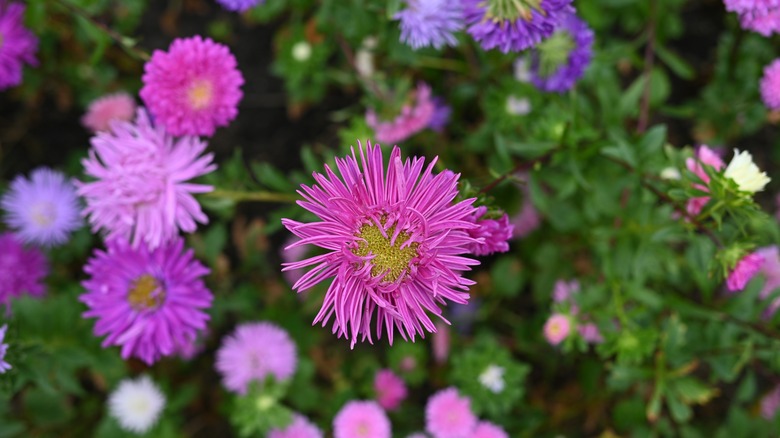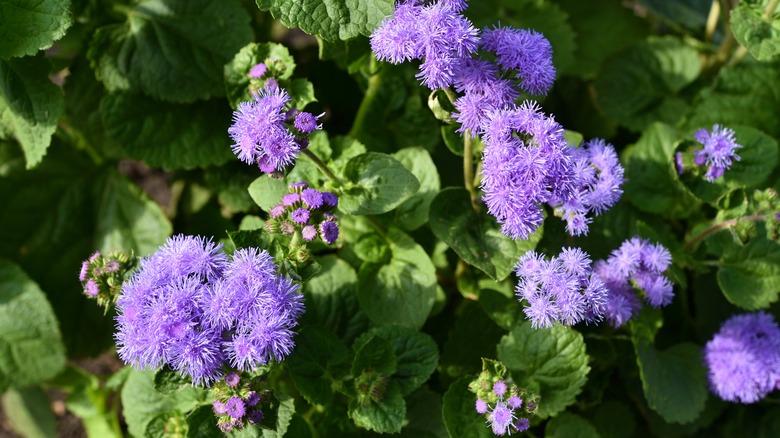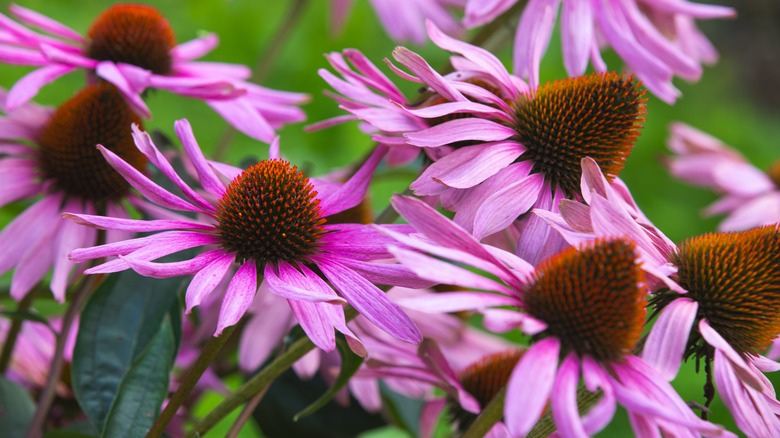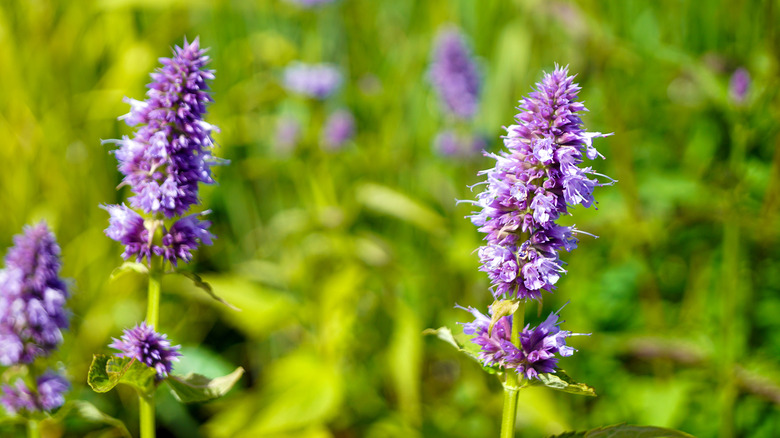12 Cold Hardy Perennials That Prefer To Be Divided In Spring, Not Fall
Fall blooming perennials do very well when divided in spring. This gives them a longer recovery time after dividing (which can cause stress) because their growth cycle is more active later in the season. They also can get well-established in their new location before winter. Some fall-blooming perennials that thrive after being divided in spring include sedum, chrysanthemums, tall phlox, Russian sage, helenium, and Japanese anemones.
Dividing perennials in spring is best done after the last frost date has passed. Dividing is already going to stress the plant a bit, and a hard frost might compound the situation. After the last hard frost, your late-season perennials should have already started showing a bit of spring growth. Some, like leadwort, are slower to wake up and you have to know where they're located to dig up the roots for dividing.
To lower the amount of stress to the plant being divided, start by watering the root system lightly, or wait until after it has rained. This moisture is soothing to the plant and will make the soil softer and easier to dig. Handle the roots gently when pulling them apart. If you need to cut the roots to divide them, use a flat-edged shovel or garden knife and cut as cleanly as possible. Replant divisions quickly. Wrap them loosely in slightly damp paper if you need to wait a day or two.
Sedum
Sedum (also known as stonecrop) is a drought-resistant plant that thrives in dry conditions. It does best in full sun and isn't fussy about soil. It is very sturdy and resilient, and easy to divide almost any time of the year. Dividing its fleshy roots in spring allows you to place divisions throughout your sunny garden for glorious color and texture from late summer through autumn. Some excellent varieties to try include 'Autumn Joy' (deep rosy red flowers), 'Matrona' (pink flowers and red-tinged stems), and 'Neon' (hot pink flowers with blue-green leaves).
Chrysanthemums
Chrysanthemums are the classic autumn-blooming perennial. Plant them in spring to give them time to establish themselves, then divide them every two or three years to multiply their beauty. Planted properly, potted mums will return each year. Mums bloom best in full sun, and they like rich, well-drained soil and plenty of water during their growth season. To divide in spring, gently cut the woody roots and water well in their new spot. Some gorgeous varieties to try are 'Whippoorwill' (pale peach), 'Jessica Louise' (pink with gold centers), 'Royal Glamour' (reddish coral), and 'Coppersmith' (deep bronze orange).
Tall phlox
Tall garden phlox (Phlox paniculata) sparkle in the late-season garden, with tall stalks topped with panicles of flowers. Closely related to creeping phlox, tall phlox come in a wide range of colors. They bloom in partial to full sun and need good air circulation to prevent powdery mildew. Phlox emerge in early spring; their woody roots can be divided with a shovel or garden knife. Heirloom varieties are fragrant and grow up to five feet tall. Newer cultivars are more compact and mildew-resistant. Try 'David' (white), 'Blue Boy' (lavender), 'Starfire' (cherry red), or 'Cleopatra' (coral pink).
Helenium
Also known as sneezewort, helenium is a tall, gorgeous perennial topped with colorful daisy-like flowers in a range of warm shades. They attract many pollinators, and aren't fussy about soil. Plant them in a sunny spot at the back of the border and give them plenty of water. The root system is woody but not too dense, and can be divided in spring as soon as green shoots appear. Try one of these vibrant cultivars: 'Red Jewel' (rose pink), 'Moerheim Beauty' (bright red and bronze), 'Mardi Gras' (orange with yellow edges), and 'Mariachi Salsa' (light to dark orange).
Russian sage
Russian sage is a tall, feathery perennial that puts out loads of violet-blue flowers in late summer, attracting many pollinators. It adds interesting texture to the garden, but its strongly aromatic scent is not to everyone's taste (except bees and butterflies), so you may want to locate it away from other late-season, more mildly fragrant flowers, such as phlox or roses. Russian sage should be pruned in spring to encourage new growth. You can dig up the woody roots to divide it in spring as soon as green leaves appear.
Japanese anemones
This charming fall-blooming perennial adds soft pastel shades of pink and creamy white to the autumn garden palette. The nodding daisy like flowers rise on tall stems above deep green leaves, and bloom nicely in partial shade areas. Some Japanese anemones spread freely by reseeding through the garden, while others stay more contained. They can be divided at the base by gently pulling the roots apart. This is best done in spring as the plants emerge, usually in mid-April. Like other types of anemone flowers, Japanese anemones like moist, rich soil.
Rudbeckia
Rudbeckia is the name of the family of daisy-like flowering plants that includes black-eyed Susans and brown-eyed Susans. There are many varieties in a range of colors. Black-eyed Susans are somewhat invasive, as they tend to reseed themselves vigorously, but other rudbeckia varieties spread less aggressively. Some varieties are less cold hardy than others, so be sure to check the growing zone. These perennials tolerate poor soil, like full sun, and bloom for weeks in late summer. Try 'Cherry Brandy' (cherry red, brown eyes), 'Prairie Sun' (two-tone yellow, green eyes), and 'Cherokee Sunset' (double petals in shades of orange).
Leadwort (hardy plumbago)
This low-growing perennial is a blue-flowering plant that adds vibrant color to the autumn flower bed. Ceratostigma plumbaginoides, also known as leadwort, hardy plumbago, and peacock plumbago flowers from late August through September, with green leaves that turn reddish bronze in October. This plant works well near early spring bulbs like daffodils and hyacinths, as it starts growing just as their foliage is dying back. Leadwort is cold hardy, deer resistant, not fussy about soil, and blooms best in full sun. The loose root system is easy to divide and replant when it emerges slowly in late spring.
New England asters
New England asters are easy-care perennials and a must-have in the autumn flower garden. Their fluffy, colorful blooms add charm and texture when many other perennials have faded. Asters have loosely spreading roots that tend to meander among other flowers. They're easily transplanted in spring when their foliage begins to emerge. They like full sun and moist, well-drained soil. There are many varieties to try, from short to tall. I recommend 'Woods Blue' (short, sky-blue flowers), 'Alma Potschke' (tall, hot pink flowers), 'Bluebird' (tall, lavender blue), and 'Honeysong Pink' (medium tall, pink with gold centers).
Ageratum (mist flower)
Perennial ageratum (taller than its annual version) is also known as mist flower. The small, button-shaped fuzzy blooms come in periwinkle blue, reddish purple, and white, and they grow to about two feet tall. They tend to spread in the garden, but their thin white roots are easy to pull up and remove. Since they emerge slowly in spring, you can see them coming up and divide them as you wish. Not fussy about soil, they bloom in partial to full sun. They add brilliant patches of easy color and feathery texture in the autumn garden.
Echinacea
Echinacea, also called coneflower, is a pollinator magnet. These hardy perennials are very low maintenance. Coneflowers are easy to grow and heirloom varieties will reseed freely through the garden. The newer hybrids come in a wider range of colors and can be divided in spring and replanted. The bright daisy-like flower petals and distinctive cone-shaped centers create a bold presence in the autumn garden. Let the seed-filled centers remain after petals fade for birds to enjoy. Try 'Rainbow Marcella' (peach-pink with brown cones), 'Pretty Parasols' (white petals tipped pink), or 'Mellow Yellows' (golden yellow, green cones).
Agastache (hummingbird mint)
Agastache, also called hummingbird mint, is well-loved by many pollinators. The fragrant, colorful flower spikes attract bees, butterflies, and hummingbirds. These charming plants look great in a cottage garden. They grow in clumps and perform best when divided every three to five years. The root clumps can be divided in spring with a shovel or sharp garden knife. Agastache is resistant to deer and rabbits, drought tolerant, and blooms in partial to full sun. It comes in a wide range of colors, including pink, blue, purple, and orange.

